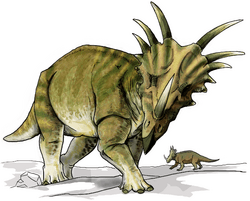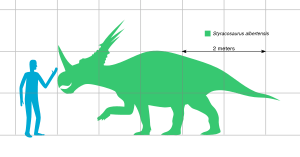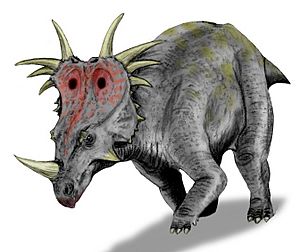Styracosaurus facts for kids
Quick facts for kids StyracosaurusTemporal range: Upper Cretaceous
|
|
|---|---|
 |
|
| Artist's impression of Styracosaurus | |
| Scientific classification | |
| Kingdom: | |
| Phylum: | |
| Class: | |
| Superorder: | |
| Order: | |
| Suborder: | |
| Infraorder: | |
| Family: | |
| Subfamily: |
Centrosaurinae
|
| Genus: |
Styracosaurus
Lambe, 1913
|
| Species | |
Styracosaurus was a type of dinosaur that ate plants. It lived during the Upper Cretaceous period, about 76.5 to 75 million years ago. This dinosaur belonged to a group called ceratopsians, which are known for their horns and frills. The name Styracosaurus means "spiked lizard," which perfectly describes its unique look.
Contents
Discovering Styracosaurus
Scientists first found Styracosaurus fossils in North America. The first bones were discovered in 1913 by Lawrence Lambe. These amazing finds helped us learn about this ancient creature.
What Styracosaurus Looked Like
Adult Styracosaurus were quite large, growing to about 5.5 meters (18 feet) long. They weighed around 2.7 tonnes, which is like two small cars!
Its Amazing Skull and Horns
The most striking part of Styracosaurus was its huge skull. It had a big nose horn that could be up to 57 centimeters (22 inches) long. This horn was tall and straight.
Behind its head, Styracosaurus had a large bony frill. This frill was covered with at least four long spikes. Each of these spikes was about 50 to 55 centimeters (20 to 22 inches) long, similar in length to its nose horn. Some Styracosaurus even had a third pair of long spikes on their frill.
The frill also had large openings, like windows, in the bone. The front of its mouth was shaped like a beak and had no teeth.
Body and Movement
The body of Styracosaurus was very strong and bulky, much like a modern rhinoceros. It had powerful shoulders. These strong shoulders might have helped them push against each other during fights. Styracosaurus had a short tail. Each of its toes had a hoof-like claw covered in horn.
Scientists believe Styracosaurus walked with its front legs in a slightly crouched position. This posture would have helped support its heavy head and body.
What Styracosaurus Ate
Since Styracosaurus was a herbivore, it ate plants. Its strong beak and teeth were perfect for munching on tough plants. It likely grazed on ferns, cycads, and other low-growing vegetation of its time.
Images for kids
-
Ceratopsian skulls, with Styracosaurus on the far left, Natural History Museum of Utah
-
Close-up of the AM5372 skull, American Museum of Natural History
-
Depiction of the megaherbivores in the Dinosaur Park Formation, Styracosaurus third from left, with herd in the right background
See also
 In Spanish: Styracosaurus albertensis para niños
In Spanish: Styracosaurus albertensis para niños









